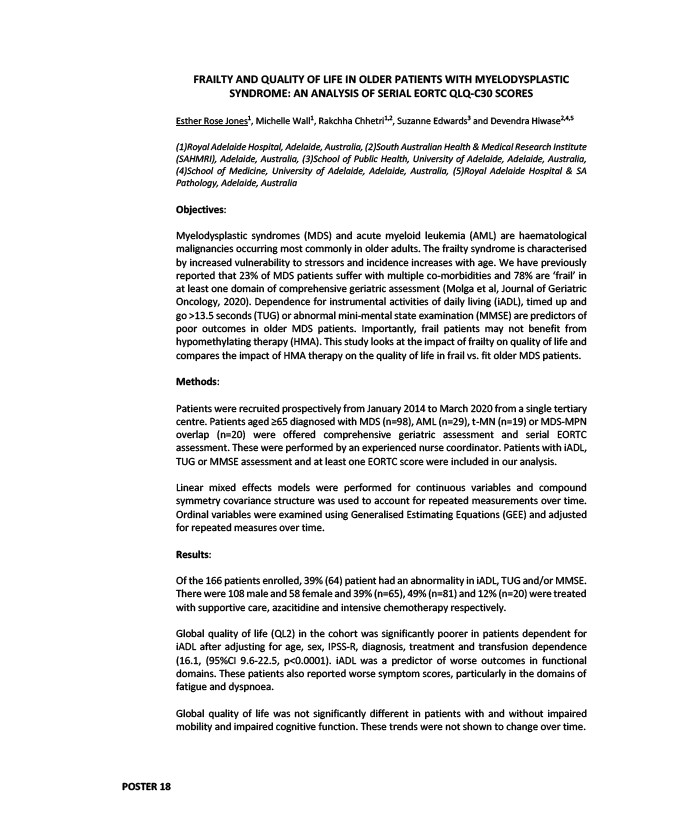
FRAILTY AND QUALITY OF LIFE IN OLDER PATIENTS WITH MYELODYSPLASTIC
SYNDROME: AN ANALYSIS OF SERIAL EORTC QLQ-C30 SCORES
Esther Rose Jones1, Michelle Wall1, Rakchha Chhetri1,2, Suzanne Edwards3 and Devendra Hiwase2,4,5
(1)Royal Adelaide Hospital, Adelaide, Australia, (2)South Australian Health & Medical Research Institute
(SAHMRI), Adelaide, Australia, (3)School of Public Health, University of Adelaide, Adelaide, Australia,
(4)School of Medicine, University of Adelaide, Adelaide, Australia, (5)Royal Adelaide Hospital & SA
Pathology, Adelaide, Australia
Objectives:
Myelodysplastic syndromes (MDS) and acute myeloid leukemia (AML) are haematological
malignancies occurring most commonly in older adults. The frailty syndrome is characterised
by increased vulnerability to stressors and incidence increases with age. We have previously
reported that 23% of MDS patients suffer with multiple co-morbidities and 78% are ‘frail’ in
at least one domain of comprehensive geriatric assessment (Molga et al, Journal of Geriatric
Oncology, 2020). Dependence for instrumental activities of daily living (iADL), timed up and
go >13.5 seconds (TUG) or abnormal mini-mental state examination (MMSE) are predictors of
poor outcomes in older MDS patients. Importantly, frail patients may not benefit from
hypomethylating therapy (HMA). This study looks at the impact of frailty on quality of life and
compares the impact of HMA therapy on the quality of life in frail vs. fit older MDS patients.
Methods:
Patients were recruited prospectively from January 2014 to March 2020 from a single tertiary
centre. Patients aged ≥65 diagnosed with MDS (n=98), AML (n=29), t-MN (n=19) or MDS-MPN
overlap (n=20) were offered comprehensive geriatric assessment and serial EORTC
assessment. These were performed by an experienced nurse coordinator. Patients with iADL,
TUG or MMSE assessment and at least one EORTC score were included in our analysis.
Linear mixed effects models were performed for continuous variables and compound
symmetry covariance structure was used to account for repeated measurements over time.
Ordinal variables were examined using Generalised Estimating Equations (GEE) and adjusted
for repeated measures over time.
Results:
Of the 166 patients enrolled, 39% (64) patient had an abnormality in iADL, TUG and/or MMSE.
There were 108 male and 58 female and 39% (n=65), 49% (n=81) and 12% (n=20) were treated
with supportive care, azacitidine and intensive chemotherapy respectively.
Global quality of life (QL2) in the cohort was significantly poorer in patients dependent for
iADL after adjusting for age, sex, IPSS-R, diagnosis, treatment and transfusion dependence
(16.1, (95%CI 9.6-22.5, p<0.0001). iADL was a predictor of worse outcomes in functional
domains. These patients also reported worse symptom scores, particularly in the domains of
fatigue and dyspnoea.
Global quality of life was not significantly different in patients with and without impaired
mobility and impaired cognitive function. These trends were not shown to change over time.
POSTER 18